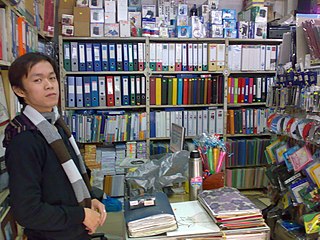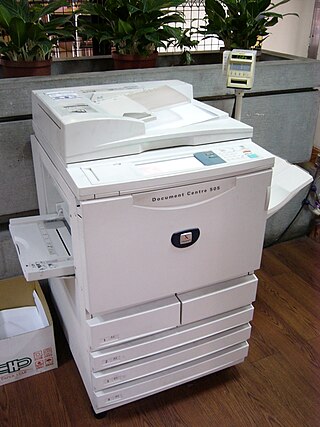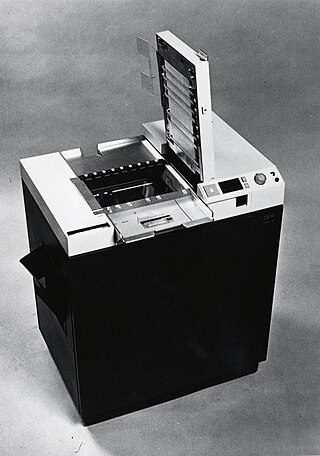
In computing, a printer is a peripheral machine which makes a durable representation of graphics or text, usually on paper. While most output is human-readable, bar code printers are an example of an expanded use for printers. Different types of printers include 3D printers, inkjet printers, laser printers, and thermal printers.

Xerox Holdings Corporation is an American corporation that sells print and digital document products and services in more than 160 countries. Xerox is headquartered in Norwalk, Connecticut, though it is incorporated in New York with its largest population of employees based around Rochester, New York, the area in which the company was founded. The company purchased Affiliated Computer Services for $6.4 billion in early 2010. As a large developed company, it is consistently placed in the list of Fortune 500 companies.

Laser printing is an electrostatic digital printing process. It produces high-quality text and graphics by repeatedly passing a laser beam back and forth over a negatively charged cylinder called a "drum" to define a differentially charged image. The drum then selectively collects electrically charged powdered ink (toner), and transfers the image to paper, which is then heated to permanently fuse the text, imagery, or both, to the paper. As with digital photocopiers, laser printers employ a xerographic printing process. Laser printing differs from traditional xerography as implemented in analog photocopiers in that in the latter, the image is formed by reflecting light off an existing document onto the exposed drum.
Duplicating machines were the predecessors of modern document-reproduction technology. They have now been replaced by digital duplicators, scanners, laser printers and photocopiers, but for many years they were the primary means of reproducing documents for limited-run distribution. The duplicator was pioneered by Thomas Edison and David Gestetner, with Gestetner dominating the market up until the late 1990s.

Print on demand (POD) is a printing technology and business process in which book copies are not printed until the company receives an order, allowing prints in single or small quantities. While other industries established the build-to-order business model, POD could only develop after the beginning of digital printing because it was not economical to print single copies using traditional printing technologies such as letterpress and offset printing.

Xerography is a dry photocopying technique. Originally called electrophotography, it was renamed xerography—from the Greek roots ξηρόςxeros, meaning "dry" and -γραφία-graphia, meaning "writing"—to emphasize that unlike reproduction techniques then in use such as cyanotype, the process of xerography used no liquid chemicals.

The Ricoh Company, Ltd. is a Japanese multinational imaging and electronics company. It was founded by the now-defunct commercial division of the Institute of Physical and Chemical Research (Riken) known as the Riken Concern, on 6 February 1936 as Riken Sensitized Paper. Ricoh's headquarters are located in Ota, Tokyo.

Toner is a powder mixture used in laser printers and photocopiers to form the text and images on paper, in general through a toner cartridge. Mostly granulated plastic, early mixtures added only carbon powder and iron oxide; now there are mixtures that contain polypropylene, fumed silica, and various minerals for triboelectrification. Toner using plant-derived plastic also exists as an alternative to petroleum plastic. Toner particles are melted by the heat of the fuser, and are thus bonded to the paper.

Office supplies are consumables and equipment regularly used in offices by businesses and other organizations, by individuals engaged in written communications, recordkeeping or bookkeeping, janitorial and cleaning, and for storage of supplies or data. The range of items classified as office supplies varies, and typically includes small, expendable, daily use items, consumable products, small machines, higher cost equipment such as computers, as well as office furniture and art.

The Gestetner is a type of duplicating machine named after its inventor, David Gestetner (1854–1939). During the 20th century, the term Gestetner was used as a verb—as in Gestetnering. The Gestetner company established its base in London, filing its first patent in 1879. The business grew, remaining within the control of the Gestetner family, and acquiring other businesses. In 1995, the Gestetner company was acquired by the Ricoh Corporation of Japan.

A microform is a scaled-down reproduction of a document, typically either photographic film or paper, made for the purposes of transmission, storage, reading, and printing. Microform images are commonly reduced to about 4% or 1⁄25 of the original document size. For special purposes, greater optical reductions may be used.
Canon Production Printing, known as Océ until the end of 2019, is a Netherlands-based subset of Canon that develops, manufactures and sells printing and copying hardware and related software. The product line includes office printing and copying machinery, production printers, and wide-format printers for both technical documentation and color display graphics.

A photocopier is a machine that makes copies of documents and other visual images onto paper or plastic film quickly and cheaply. Most modern photocopiers use a technology called xerography, a dry process that uses electrostatic charges on a light-sensitive photoreceptor to first attract and then transfer toner particles onto paper in the form of an image. The toner is then fused onto the paper using heat, pressure, or a combination of both. Copiers can also use other technologies, such as inkjet, but xerography is standard for office copying.
Document capture software refers to applications that provide the ability and feature set to automate the process of scanning paper documents or importing electronic documents, often for the purposes of feeding advanced document classification and data collection processes. Most scanning hardware, both scanners and copiers, provides the basic ability to scan to any number of image file formats, including: PDF, TIFF, JPG, BMP, etc. This basic functionality is augmented by document capture software, which can add efficiency and standardization to the process.
The Kodak Ektaprint Electronic Publishing System (KEEPS) was a professional electronic publishing system sold internationally by the Eastman Kodak Company from 1987–1992. KEEPS was a fully integrated turnkey system, consisting of publishing software from Interleaf, computer hardware from Sun Microsystems, customized front-end software developed by Kodak that ran on Unix System V Release 4, and Kodak's high-end scanners and Ektaprint printers and copiers.
Katun is a supplier of OEM-compatible imaging consumables and supplies for office equipment.

Printer tracking dots, also known as printer steganography, DocuColor tracking dots, yellow dots, secret dots, or a machine identification code (MIC), is a digital watermark which many color laser printers and copiers produce on every printed page that identifies the specific device that was used to print the document. Developed by Xerox and Canon in the mid-1980s, the existence of these tracking codes became public only in 2004.

The IBM 6670 Information Distributor (6670-001) was a combination laser printer and photocopier introduced by IBM. Announced on February 14, 1979, as part of Office System/6, its feature set included two-sided printing.

IBM Office Products Division (OPD) manufactured and sold copier equipment and supplies from 1970 till IBM withdrew from the copier market in 1988. IBM's decision to compete in this market resulted in the first commercial use of an organic photoconductor now widely used in most photocopiers. It is often held up as an example of a corporate u-turn, where a company rejects a technology and then adopts it. It showed that despite the size of IBM's sales and engineering organisations, this did not guarantee success in every market it chose to compete in. The development effort that resulted in the IBM Copier helped in the development of IBMs first laser printer, the IBM 3800.`

IBM manufactured and sold microfilm products from 1963 till 1969. It is an example of IBM attempting to enter an established market on the basis of a significant technical breakthrough.














